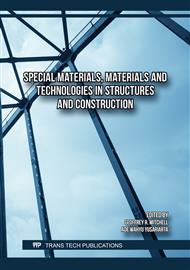[1]
C.Liu, Y.Shi, A thermo-viscoelastic analytical model for residual stresses and spring-in angles of multilayered thin-walled curved composite parts, Thin-Walled Structures. 152(2020) 106758.
DOI: 10.1016/j.tws.2020.106758
Google Scholar
[2]
U.P. Breuer, Commercial aircraft composite technology, Springer (2016).
Google Scholar
[3]
D.K. Lim, K.B. Mustapha, C. P. Pagwiwoko.Delamination detection in composite plates using random forests. Composite Structures. 4 (2021) 114676.
DOI: 10.1016/j.compstruct.2021.114676
Google Scholar
[4]
E.F. Rybicki, M.F. Kanninen. A finite element calculation of stress intensity factors by a modified crack closure integral. Engineering Fracture Mechanics. 9(4) (1977) 931-938.
DOI: 10.1016/0013-7944(77)90013-3
Google Scholar
[5]
G.I. Barenblatt. The mathematical theory of equilibrium cracks in brittle fracture. Advances in Applied Mechanics. 7(1) (1962) 55-129.
DOI: 10.1016/s0065-2156(08)70121-2
Google Scholar
[6]
G. Alfano. On the influence of the shape of the interface law on the application of cohesive-zone models. Composite Science and Technology. 66 (2006) 723-30.
DOI: 10.1016/j.compscitech.2004.12.024
Google Scholar
[7]
K.H. Nguyen, H.W. Ju,V.H. Truong, et al. Delamination analysis of multi-angle composite curved beams using an out-of-autoclave material. Composite Structures. 183 (2018) 320-330.
DOI: 10.1016/j.compstruct.2017.03.078
Google Scholar
[8]
A. Turon, P.P. Camanho, J. Costa, et al. Accurate simulation of delamination growth under mixed-mode loading using cohesive elements: definition of interlaminar strengths and elastic stiffness. Composite Structures. 92(8) (2010) 1857-1864.
DOI: 10.1016/j.compstruct.2010.01.012
Google Scholar
[9]
D.F. Cao, H.X. Hu, Q.F. Duan, et al. Experimental and three-dimensional numerical investigation of matrix cracking and delamination interaction with edge effect of curved composite laminates. Composite Structures. 225 (2019) 111154.
DOI: 10.1016/j.compstruct.2019.111154
Google Scholar
[10]
T. Kim, T.A. Fletcher, T.J. Dodwell, et al. The effect of free edges on inter-laminar performance of curved laminates. In: 56th AIAA/ASCE/AHS/ASC Structures, Structural Dynamics, and Materials Conference (2015).
DOI: 10.2514/6.2015-0968
Google Scholar
[11]
J.S. Charrier, F.Laurin, N.Carrere, et al. Determination of the out-of-plane tensile strength using four-point bending tests on laminated L-angle specimens with different stacking sequences and total thicknesses. Composite Part A, Applied Science & Manufacturing. 81(2016) 243-53.
DOI: 10.1016/j.compositesa.2015.11.018
Google Scholar
[12]
W. Hao, D. Ge, Y. Ma, et al. Experimental investigation on deformation and strength of carbon/epoxy laminated curved beams. Polymer Testing. 31(4) (2012) 520-6.
DOI: 10.1016/j.polymertesting.2012.02.003
Google Scholar
[13]
D. Ranz, J. Cuartero, A. Miravete, et al. Experimental research into interlaminar tensile strength of carbon/epoxy laminated curved beams. Composite Structures. 164(15) (2017) 189-97.
DOI: 10.1016/j.compstruct.2016.12.010
Google Scholar
[14]
A.Y. Al-Maharma, S.P. Patil, B. Markert, et al. Effects of porosity on the mechanical properties of additively manufactured components: a critical review. Materials Research Express. 7(12) (2020) 122001.
DOI: 10.1088/2053-1591/abcc5d
Google Scholar
[15]
M.J. Suriani, H.Z. Rapi, R.A. Ilyas, Delamination and Manufacturing Defects in Natural Fiber-Reinforced Hybrid Composite: A Review. Polymers. 13 (2021) 1323.
DOI: 10.3390/polym13081323
Google Scholar
[16]
W. Li, C. Zhang, H. Ye, et al. Effect of curing pr et al. ocess parameters on the properties of domestic T800 reinforced high toughness composites.Composites Science and Engineerin. 06 (2020) 98-104.
Google Scholar
[17]
H. Koushyar, S. Alavi-Soltani, B. Minaie, et al. Effects of variation in autoclave pressure, temperature, and vacuum-application time on porosity and mechanical properties of a carbon fiber/epoxy composite. Journal of Composite Materials. 44(16) (2011) 1985-2004.
DOI: 10.1177/0021998311429618
Google Scholar
[18]
W.Zhou, W. Zhu, Q. Xu, et al. Out-of-plane tensile failure behavior of fiber reinforced composites due to lay-up temperature induced intra-ply and inter-ply voids. Composite Structures. 271 (2021) 1-11.
DOI: 10.1016/j.compstruct.2021.114150
Google Scholar
[19]
L. Zhang. Delamination extension behavior and numerical simulation of composite laminates with delamination defects. Harbin Institute of Technology. (2012).
Google Scholar
[20]
M.L. Benzeggagh, M. Kenane. Measurement of mixed-mode delamination fracture toughness of unidirectional glass/epoxy composite with mixed-mode bending apparatus. Composites Science and Technology. 56(4) (1996) 439-449.
DOI: 10.1016/0266-3538(96)00005-x
Google Scholar
[21]
P.P. Camanho. Mixed-mode decohesion finite elements for the simulation of delamination in composite materials. NASA/T M-211737-2002. Washington D C, NASA. (2002).
Google Scholar
[22]
American Society for Testing and Materials. Standard test method for measuring the curved beam strength of fiber reinforced polymer matrix composite: D6415/D6415M-06a. West Conshohocken, PA: ASTM International. (2013).
Google Scholar
[23]
A. Turon, P.P. Camanho, J. Costa, et al. Accurate simulation of delamination growth under mixed-mode loading using cohesive elements: definition of interlaminar strengths and elastic stiffness. Composite Structures. 92(8) (2010) 1857-1864.
DOI: 10.1016/j.compstruct.2010.01.012
Google Scholar


